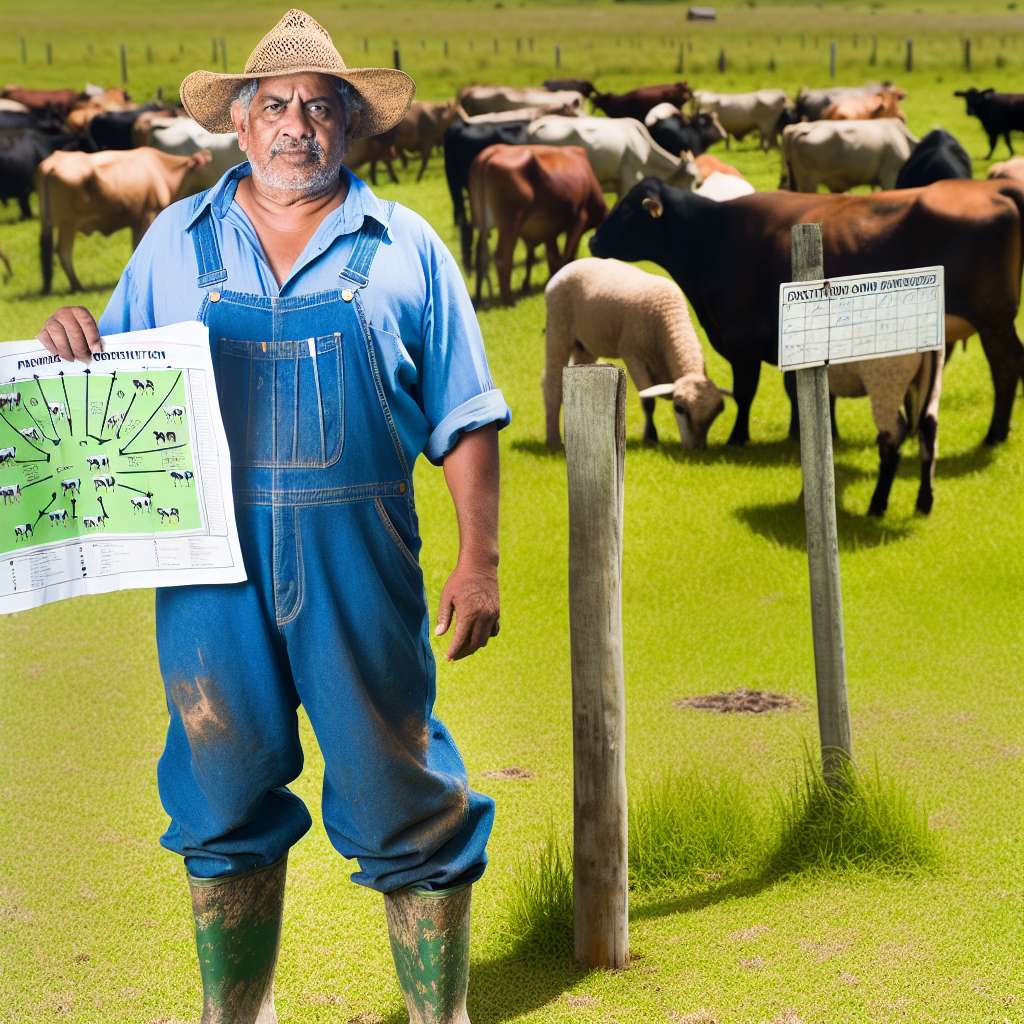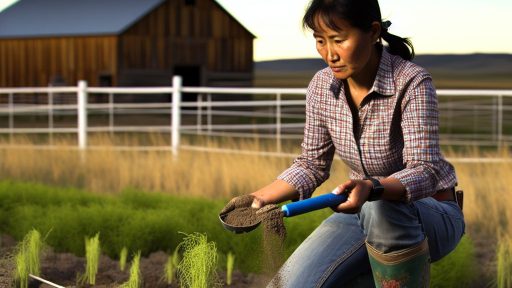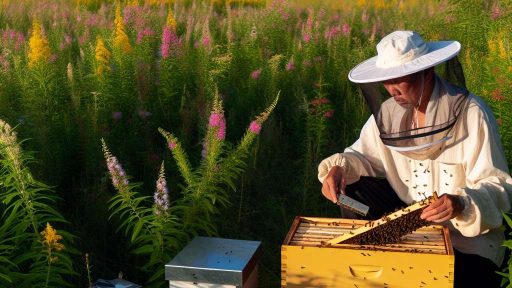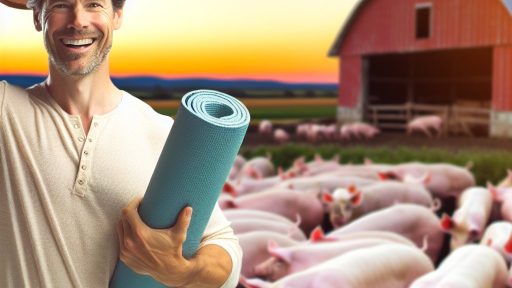Introduction to Pasture Rotation
Pasture rotation refers to the strategic movement of livestock between different grazing areas.
This practice promotes healthier pastures and livestock alike.
It relies on the principle of letting pastures rest and recover.
By doing so, farmers enhance soil health and forage quality.
Moreover, pasture rotation helps combat overgrazing.
Overgrazing negatively affects both plant health and soil quality.
Additionally, it supports sustainable livestock farming practices.
Farmers can increase their overall productivity through effective management.
Understanding pasture rotation is essential for modern agriculture.
It embodies a proactive approach to maintaining ecological balance.
Farmers implementing this strategy can enhance nutrient cycling.
This practice aids in promoting biodiversity within grazing lands.
Ultimately, healthy pastures lead to healthier livestock.
Therefore, pasture rotation is crucial for sustainable farming.
Key Benefits of Pasture Rotation in Sustainable Livestock Farming
Enhanced Soil Health
Pasture rotation significantly improves soil health.
Transform Your Agribusiness
Unlock your farm's potential with expert advice tailored to your needs. Get actionable steps that drive real results.
Get StartedIt promotes nutrient cycling, which enriches the soil.
Additionally, diverse root structures enhance soil structure.
This leads to better water retention in the soil.
Improved Grass Productivity
Rotating pastures boosts grass growth and productivity.
Healthy pastures produce more forage for livestock.
More forage availability supports higher livestock yields.
Consequently, farmers benefit from increased productivity.
Reduction in Pest and Disease Pressure
Pest populations decline with pasture rotation.
Changing grazing areas disrupt pest life cycles.
Additionally, it reduces the risk of overgrazing.
This strategy helps maintain herd health over time.
Efficient Use of Resources
Pasture rotation maximizes the use of available land.
It allows for better management of grazing pressure.
Farmers can implement strategic rest periods for pastures.
This practice ultimately leads to enhanced forage quality.
Environmental Benefits
Implementing pasture rotation improves biodiversity.
It creates habitats for beneficial insects and wildlife.
Moreover, well-managed pastures sequester carbon effectively.
This supports efforts to combat climate change.
Financial Sustainability
Pasture rotation can lower feed costs for farmers.
By using natural grasses, farmers reduce reliance on supplements.
Additionally, improved pasture productivity leads to increased profits.
This approach enhances financial resilience in farming.
Types of Pasture Rotation Systems
Continuous Rotation
Continuous rotation, also known as unrestricted grazing, allows livestock free access to pastureland.
Showcase Your Farming Business
Publish your professional farming services profile on our blog for a one-time fee of $200 and reach a dedicated audience of farmers and agribusiness owners.
Publish Your ProfileThis method often leads to overgrazing in certain areas.
Consequently, the grass can weaken and become less productive.
Additionally, soil erosion may increase due to lack of vegetation cover.
Despite these drawbacks, continuous rotation offers simplicity in management.
Farmers often prefer this system due to the lower labor requirements involved.
Planned Rotation
Planned rotation involves a structured approach to grazing management.
This method divides pastureland into smaller sections.
Livestock rotate between these sections periodically.
As a result, this system promotes pasture recovery and regrowth.
Farmers can implement specific grazing schedules.
For instance, animals may graze one section while others rest.
This practice enhances soil health and ecosystem balance.
Moreover, planned rotation increases forage availability and quality.
Ultimately, it leads to better livestock production outcomes.
Comparative Benefits
Choosing between continuous and planned rotation requires careful consideration.
Continuous systems are easier to implement but may harm pasture health over time.
In contrast, planned rotation demands more initial effort and oversight.
However, the benefits of improved pasture health often outweigh the labor investment.
Farmers should evaluate their specific needs and resources wisely.
You Might Also Like: Implementing Climate-Resilient Solutions For Organic Livestock Management
Factors to Consider When Designing a Pasture Rotation Plan
Understanding Forage Growth Patterns
Forage species exhibit varying growth rates throughout the season.
Recognizing these patterns aids in optimizing pasture use.
Additionally, understanding which species thrive in your region is crucial.
Assessing Livestock Needs
Each type of livestock has unique dietary requirements.
Consider the nutritional needs of your herd or flock when planning.
This ensures livestock remain healthy and productive.
Evaluating Soil Health
Soil quality directly influences forage production.
Test your soil regularly to monitor nutrient levels.
This helps identify any amendments needed for optimal growth.
Implementing Water Access
Livestock must have consistent access to fresh water.
Consider creating natural or artificial water sources throughout the pasture.
Effective water management enhances livestock wellbeing.
Monitoring Environmental Conditions
Weather patterns influence pasture health and livestock behavior.
Be prepared to adjust your rotation plan based on seasonal changes.
Incorporate seasonal weather forecasts into your planning process.
Planning for Rest Periods
Pastures need suitable recovery time to regenerate after grazing.
Establish rest periods that allow forage plants to recover fully.
This enhances the sustainability of your pasture system.
Integrating Diversification
Diverse forage species contribute to overall pasture resilience.
Incorporate legumes to improve soil fertility and reduce feed costs.
Showcase Your Farming Business
Publish your professional farming services profile on our blog for a one-time fee of $200 and reach a dedicated audience of farmers and agribusiness owners.
Publish Your ProfileMoreover, consider intercropping to maximize land use efficiency.
Adaptability to Change
Flexibility is vital for successful pasture management.
Regularly review and adjust your rotation plan as needed.
This helps address unexpected challenges and changing conditions.
Uncover the Details: Remote Sensing in Precision Livestock Farming for Improved Feed Management
Implementing Pasture Rotation: Step-by-Step Guide
Assessing Your Land
Begin by evaluating the total area of your pasture.
Identify the soil types present in your fields.
Analyze water availability and drainage patterns.
Additionally, consider the types of grasses and legumes that grow.
Defining Your Livestock Needs
Determine the number and type of livestock you plan to graze.
Understand their nutritional requirements for optimal health.
Factor in their grazing behavior and preferences.
Creating a Rotational Plan
Map out different grazing zones on your property.
Establish a grazing schedule to rotate livestock effectively.
Ensure that each pasture has adequate rest periods to recover.
Implementing Fencing and Water Supply
Install durable fencing to keep livestock in designated areas.
Ensure a reliable water supply in each pasture section.
Consider using troughs or natural water sources.
Monitoring and Adjusting Practices
Regularly observe pasture health and livestock condition.
Be prepared to adjust your rotation schedule as needed.
Incorporate feedback from soil health indicators for improvements.
Using Technology for Better Management
Utilize apps that track grazing patterns and livestock movements.
Consider GPS technology for precise pasture management.
Data-driven decisions can enhance overall sustainability.
Discover More: Sustainable Livestock Practices for Regenerative Agriculture
Best Forage Species for Pasture Rotation: Selection and Management
Importance of Forage Selection
Choosing the right forage species is crucial for successful pasture rotation.
Healthy forage improves livestock nutrition and enhances soil health.
A diverse mix of forages also contributes to better pest and disease management.
Key Attributes of Ideal Forage Species
Look for forages that exhibit drought resistance and rapid growth.
Consider species that can withstand grazing pressure and maintain productivity.
Additionally, select forages with high palatability to promote consumption by livestock.
Popular Forage Species
- Perennial ryegrass is known for its quick establishment and robust growth.
- Tall fescue provides good drought tolerance and is ideal for mixed grazing systems.
- Alfalfa is rich in protein and supports healthy milk production in dairy cattle.
Managing Forage Health
Proper management practices ensure sustained forage health and productivity.
Regular soil testing helps to determine nutrient needs for optimal growth.
Implementing rotational grazing can prevent overgrazing and soil degradation.
Timing of Sowing and Grazing
Timing plays a significant role in forage establishment and health.
Plant cool-season forages in early spring and warm-season species in late spring.
Monitor growth stages to determine the best grazing times for livestock.
Benefits of Diverse Forage Systems
Diverse forage systems enhance pasture resilience against environmental stressors.
They reduce the risk of plant disease and pest outbreaks.
Moreover, they contribute to improved soil structure and erosion control.
Showcase Your Farming Business
Publish your professional farming services profile on our blog for a one-time fee of $200 and reach a dedicated audience of farmers and agribusiness owners.
Publish Your ProfileLearn More: Sustainable Livestock Practices for Minimizing Antibiotic Use

Monitoring and Assessment: Evaluating the Success of Your Pasture Rotation
The Importance of Monitoring
Regular monitoring is crucial for successful pasture rotation.
It helps identify strengths and weaknesses in your grazing practices.
Additionally, ongoing assessment informs necessary adjustments.
Key Indicators of Pasture Health
Evaluating pasture health involves several key indicators.
- Soil quality is fundamental for nutrient availability.
- Grass species diversity impacts ecosystem resilience.
- Livestock performance reflects the effectiveness of grazing strategies.
- Presence of weeds can indicate management issues.
Techniques for Monitoring
Implementing effective monitoring techniques enhances results.
Visual assessments provide immediate insights into pasture conditions.
Photographic records help track changes over time.
Soil testing offers precise information on nutrient levels.
Using grazing charts can optimize livestock distribution.
Gathering Feedback from Livestock
Pay attention to livestock behavior as a critical assessment tool.
Healthy animals typically indicate good pasture conditions.
If livestock avoid certain areas, investigate potential issues.
Monitor weight gain and overall health regularly.
Evaluating Financial Outcomes
Assessing financial impacts reveals the economic viability of your practices.
Track costs associated with different grazing patterns and their outcomes.
Consider the return on investment from improved pasture health.
Continuous Improvement Through Assessment
Use gathered data to inform future pasture management decisions.
Adaptations should be based on both successes and challenges.
Develop a routine for regular evaluations to ensure long-term sustainability.
Common Challenges in Pasture Rotation and How to Overcome Them
Understanding Pasture Degradation
Pasture degradation poses a significant challenge for farmers.
It reduces land productivity over time.
Additionally, overgrazing leads to soil erosion and compaction.
Farmers often struggle to maintain grass growth.
Consequently, maintaining soil health becomes difficult.
Implementing Effective Rotation Plans
Creating an effective rotation plan requires careful consideration.
Farmers must assess land quality before implementing changes.
Poor planning can lead to uneven grazing patterns.
Thus, it’s important to monitor pasture condition regularly.
Managing Weather Variability
Weather plays a crucial role in pastoral farming.
Droughts can limit grass growth significantly.
Furthermore, excessive rainfall might lead to waterlogged soil.
Farmers must be proactive in adapting their strategies to changing weather conditions.
Addressing Livestock Health Issues
Livestock health can also impact pasture rotation success.
Overcrowding can lead to stress and disease among animals.
Hence, farmers should ensure proper stocking rates.
Monitoring animal health regularly is essential.
Utilizing Technology for Better Management
Technology can greatly aid in pasture rotation management.
For instance, data tracking tools can monitor soil health.
Moreover, digital mapping can help identify ideal grazing areas.
Showcase Your Farming Business
Publish your professional farming services profile on our blog for a one-time fee of $200 and reach a dedicated audience of farmers and agribusiness owners.
Publish Your ProfileEmbracing technology makes it easier to make informed decisions.
Educating and Training Staff
Education and training are crucial for staff involved in pasture management.
Knowledgeable staff can implement rotation strategies effectively.
Additionally, ongoing training helps keep everyone up-to-date on best practices.
Investing in human resources will contribute to long-term success.
Fostering Sustainable Practices
Implementing sustainable practices can alleviate some challenges.
Crop rotation, mixed grazing, and cover crops enhance pasture quality.
Furthermore, these practices improve soil structure and fertility.
By focusing on sustainability, farmers can achieve better long-term results.
Case Studies: Successful Pasture Rotation Strategies from Around the World
Rotational Grazing in New Zealand
New Zealand farmers effectively use rotational grazing to enhance pasture health.
This method allows pastures to recover while livestock graze in designated areas.
Farmers rotate sheep and cattle across multiple paddocks for optimal grass regrowth.
As a result, they report better weight gain in livestock and improved soil health.
Holistic Planned Grazing in the United States
In the United States, holistic planned grazing has gained popularity.
This strategy focuses on matching livestock density with pasture capacity.
Farmers assess land conditions regularly to adapt grazing patterns accordingly.
Such practices lead to improved biodiversity and eco-friendly landscapes.
Silvo-Pastoral Systems in Spain
Spain showcases successful integration of forestry and grazing through silvo-pastoral systems.
This approach allows livestock to graze beneath trees while benefiting from shade and forage.
Additionally, this system enhances carbon storage in the ecosystem.
Farmers see advantages like increased milk production and reduced feed costs.
Continuous Grazing Challenges in Australia
In Australia, some farmers practice continuous grazing, leading to negative impacts.
This method often results in overgrazing and degraded soil quality over time.
Farmers face challenges in managing pasture health and livestock survival.
Shifting towards more strategic grazing methods is crucial for long-term sustainability.
Regenerative Agriculture in Argentina
Argentina offers inspiring examples of regenerative agriculture combined with pasture rotation.
This method focuses on restoring soil fertility through diverse grazing systems.
Farmers encourage natural ecosystems to flourish, benefiting local wildlife and crops.
As a result, they achieve higher yields and healthier livestock.
Additional Resources
Paddock Design, Fencing, Water Systems, and Livestock Movement …




